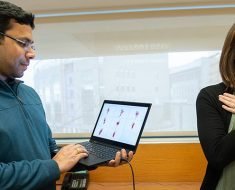Autologous breast reconstruction techniques are classified into different types based on the composition of flaps and the source of the tissue.
Flaps from the Abdomen
TRAM Flap
TRAM refers to the transverse rectus abdominis muscle that extends between the waist and the pubic bone. In the TRAM flap method, a flap of tissue containing skin, fat, and the rectus abdominus muscle is raised and used to rebuild the breast. TRAM flaps are the most preferred method of flap reconstruction, as the TRAM flap tissue is very similar to the tissue in the breast. However, the need to cut through the muscle in this technique makes it a somewhat harsher procedure, as compared to other flap types which require “gentler” surgeries.
TRAM flaps are of 2 types – free or pedicled. While pedicled flaps are introduced in the breast area along with the accompanying blood vessels, free flaps contain the tissue that is separated from its blood supply, and is reattached to the blood vessels present in the breast area.
DIEP Flap
DIEP is short for ‘deep inferior epigastric perforator artery’, a vessel that runs across the abdomen. A DIEP flap is the same as a TRAM flap, except that no muscle is raised for this procedure. Instead, the skin, fat, and blood vessels are removed from the lower abdomen and moved to the chest area for reconstruction.
SIEA Flap
SIEA stands for the ‘superficial inferior epigastric artery’, which runs beneath the skin of the lower abdomen. A SIEA flap differs from a DIEP flap in that a different set of abdominal blood vessels is removed along with the skin and fat. Also, the DIEP flap involves a small incision in the fascia layer, while no incision is required for the SIEA flap procedure, nor does it disturb the muscle at all.
Flap from the Back
Latissimus Dorsi Flap
Here the flap that is raised is from the latissimus dorsi muscle in the back, below the shoulder and behind the armpit. In this procedure, an oval portion of the skin, muscle, fat, and blood vessels is used to recreate the breast. The tissue is moved under the skin to the chest area along with the original artery and vein.
Flap from the Hips / Buttocks
SGAP Flap / Hip Flap
GAP refers to a blood vessel called the gluteal artery perforator, which runs through the buttocks. In a superior GAP (SGAP) flap procedure, the blood vessel, skin, and fat from the hip or upper buttocks is used to rebuild the breast. This procedure does not involve the removal of muscle.
IGAP Flap
IGAP or inferior GAP procedure is another GAP flap procedure that uses tissue from the bottom of the buttocks to rebuild the affected breast. This is a more common procedure than the IGAP flap.
Flap from the Thighs
TUG Flap
TUG stands for transverse upper gracilis, and the TUG flap is taken from the gracilis muscle in the upper inner thigh. During this procedure, skin, muscle, fat, and blood vessels from the upper thigh are used to recreate the breast. This type of reconstruction is a good option for patients who are not ideal candidates for TRAM or other types of reconstruction due to lack of adequate tissue in the abdomen.
PAP Flap
PAP refers to profunda artery perforator, which is a blood vessel running through the thigh. In a PAP flap, this blood vessel is used to rebuild the breast, along with the skin and fat from the back of the upper thigh. It does not involve any muscle-grafting, and is suitable for women with small breasts.
Multi-Component or Hybrid Flap Reconstruction
Stacked DIEP Flap
This procedure is a newer version of the DIEP flap reconstruction and can be used in women who have very low belly tissue, and so are not eligible for DIEP flap reconstruction. Here each DIEP flap is stacked with another free flap for added volume and better cosmetic advantage.
Body Lift Perforator Flap
This method was pioneered at the Center for Restorative Breast Surgery. It is a combination of DIEP flap reconstruction and SGAP/hip flap reconstruction. While DIEP uses tissue from the abdomen, SGAP uses flaps from the upper buttocks. Body lift is a good option for thin women with medium-sized breasts who prefer autologous reconstruction.
Stacked /"Hybrid" GAP Flap
This is another version of GAP that is ideal for women who have less tissue over the buttocks and hence are not eligible for standard GAP reconstruction. Here again, the GAP flaps are stacked one over other for added volume.
Reconstruction Using Fat Tissue
Fat Grafting – This is also known as autologous fat transfer and is a relatively new type of reconstruction. It uses fat tissue removed from elsewhere in the body such as the abdomen, thighs, or buttocks by liposuction to rebuild the breast. The fat tissue is converted into liquid form and injected into the affected breast so as to recreate normal contours.
References
- http://www.breastcancer.org/treatment/surgery/reconstruction/types/autologous
- http://www.cancer.gov/types/breast/reconstruction-fact-sheet
- http://www.ncbi.nlm.nih.gov/pmc/articles/PMC2464250/
- http://www.mayoclinic.org/tests-procedures/breast-reconstruction/basics/what-you-can-expect/prc-20020499
Further Reading
- All Breast Reconstruction Content
- Autologous versus Prosthetic Breast Reconstruction
- Surgery for Breast Cancer
Last Updated: Feb 26, 2019

Written by
Susha Cheriyedath
Susha has a Bachelor of Science (B.Sc.) degree in Chemistry and Master of Science (M.Sc) degree in Biochemistry from the University of Calicut, India. She always had a keen interest in medical and health science. As part of her masters degree, she specialized in Biochemistry, with an emphasis on Microbiology, Physiology, Biotechnology, and Nutrition. In her spare time, she loves to cook up a storm in the kitchen with her super-messy baking experiments.
Source: Read Full Article





